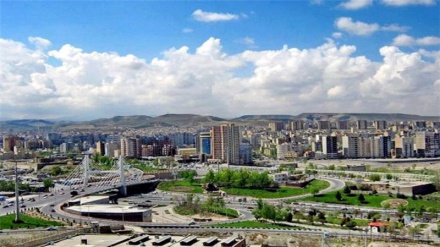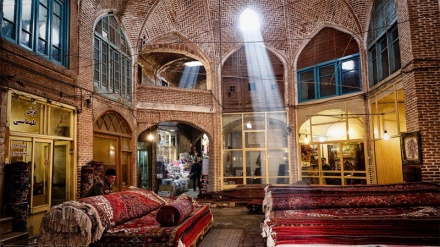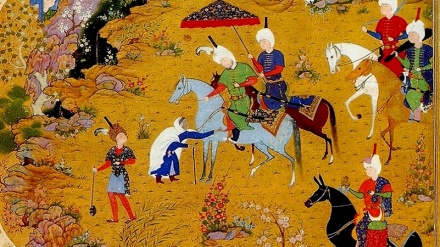Tabriz, 2018 (1)
Throughout the 9th confab of tourism ministers of the Organization for Islamic Cooperation member states, the participants decided to select one city as the tourism capital of Islamic countries, every year.
To this end, in the years 2015, 2016, and 2017; respectively the cities of Quds, Konia, and Medina were selected as the tourism capitals of Islamic countries. For the year 2018, the Iranian city of Tabriz has been chosen as the capital of Islamic countries. Thus, in the series Tabriz, the glittering turquoise of the world of Islam, which consists of twenty-six episodes, we intend to make you more familiar with this touristic and historical city.
There are many ancient cities in Asia; and Tabriz is one of these historical and ancient cities. The discovery of antiques in the center of this city, and in the vicinity of Kaboud Mosque, has drawn the attention of archeologists toward this region of Azarbaijan Province, and has ranked this city as one of the most ancient cities of the world. Prior to these discoveries, the history of Tabriz was shrouded in obscurity. However, the findings in Kaboud Mosque unveiled a mysterious world before the very eyes of researchers, and upon the discovery of items, remaining from the Bronze Age, and other phases of history, we become aware of the 5,000-year history of the city of Tabriz.
Based on historical accounts, prior to entry of Aryan migrants to Iran, a number of governments were established in Azarbaijan. Based on the remarks of Richard Nelson Frye, who has authored a book on the historical heritage of Iran; in western Iran, Medes and other Iranian newcomers encountered the majority of locals, who did not converse in Indo-European Languages.
Tabriz is the 3rd largest city in Iran, maintaining an especial status in Iran's history, culture, and economy. The historical capital of East Azarbaijan Province has gone through many upheavals, and has witnessed numerous incidents. At one time, Tabriz was a small village in the vicinity of Sahand Mountains, and was also later chosen as the capital city of Iran. Throughout the course of history, this city has been the epicenter of a number of destructive earthquakes, and has been reduced to ashes a number of times. However, every time, it has been rebuilt by the hardworking and courageous residents of this region. Currently, Tabriz is the economic, administrative, commercial, industrial, military, and communicational pole of northwestern Iran, and plays a decisive role in the protection of the borders and territorial integrity of Iran. The residents of this city, alongside maintenance of their cultural and historical traditions and roots, have made utmost efforts to enhance the quality of their urban lives.
The first print house with Arabic and Farsi letters was founded in the city of Tabriz in the year 1816 AD, by Mirza Zain al-Abedin Tabrizi, who earned the title of Father of Iran's Print Industry. The first translation of a foreign book from English to Farsi was carried out in this city. Also, the first prose book for children was published in Tabriz.
Libraries are one of the most important sources of science and culture in cities. In this domain, the city of Tabriz is ranked first in Iran.
Soli Movie Theater is the first Iranian cinema which was founded in Tabriz, five years after the invention of cinema. Also, the first movie theater in the capital of Iran, was opened by a Tabrizi citizen, named Ali Vakili, in the year 1926 AD. The first publication in the field of cinema in Iran was also released by the same individual, a few years later.
Tabriz has also pioneered visual arts in Iran, and the first shows were staged by Mirza Aqa Tabrizi, throughout the rule of Qajarid King, Naser Ed-Din Shah.
Mr. Jabbar Asgarzadeh, otherwise known as Baaghcheban, the publisher of children's books in Iran, founded the first school for deaf and dumb pupils in the city of Tabriz, raising an opportunity for deaf children to learn and acquire knowledge. Also, Abul-Qasem Fiouzaat founded the first Iranian kindergarten in the city of Tabriz. Furthermore, Tabriz is also one of the pioneering cities in higher education, and the first Faculty of Nursing of Iran was founded in this city.
Moreover, the advancements and achievements of the people of Tabriz in the field of medicine are also significant and breath-taking. For instance, the first Iranian student, who was sent overseas for further education by the then crown prince, Abbas Mirza, was a resident of the city of Tabriz, and the first medical books in Iran were compiled, translated, and published in that city. It is also noteworthy that the first smallpox vaccination in Iran was carried out in the city of Tabriz.
These features of the city of Tabriz, in addition to its unique historical and contemporary structures, scenic landscapes; its people's cultural, ethnic, and racial characteristic traits, it's one of a kind souvenirs, carpets, and handicrafts, as well as many other especial features, have transformed this city into the glittering gem of the cities of Iran.
In the meantime, positive measures have been taken in the city of Tabriz. Upon the utmost efforts of Tabriz mayor, and upon the assistance of media publicity, the majority of people of Tabriz have been informed of the selection of city of Tabriz as an exemplary touristic city of the World of Islam in the year 2018. This selection has been made with the due consideration of historical, cultural, and religious factors. The city of Tabriz has managed to introduce itself as the most modern, healthy, beautiful, and developed city of Iran to the international community. Focus on the important features of this title is of paramount significance. Obviously, paying attention to the historical, cultural, social, and religious backgrounds of the city of Tabriz is the most important factor behind the further progress and development of this city.
Meanwhile, the 2018 logo of the city of Tabriz has been designed by Ms. Leila Hojbi, and has been inspired by the historical monuments of the city of Tabriz. The simplicity of this logo is one of its strong points.
Tourism industry is one of the most important sources of revenues, and one of the means for liberation from the yoke of dependence on oil revenues. The introduction of the history, culture, and art of the city of Tabriz, and announcement of the importance of this city in the domain of Iran's culture, and within the World of Islam, can encourage tourists to visit this city.
Given that in the current Iranian solar calendar year, several especial programs have been considered for introduction of the city of Tabriz; this series also intends to familiarize listeners with this city. So, accompany us in our visit to the city of Tabriz as of next week.
MR/ME


